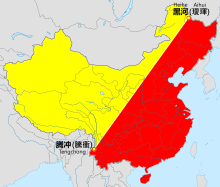TMSR-LF1


TMSR-LF1 (液态燃料钍基熔盐实验堆; "liquid fuel thorium-based molten salt experimental reactor") is a 2 MWt prototype molten salt reactor (MSR) currently under construction in an industrial park in Minqin County,[1] in the province of Gansu in northwest China.[2][3][4] Construction is expected to finish in August 2021, with a test run as early as September.[5][6]
Background[]

cf. plant map.
In January 2011, the Chinese Academy of Sciences began the TMSR research and development project to create reactors which, among other advances, will be air-cooled.[7] The liquid fuel ("LF") design is descended from the 1960s Molten-Salt Reactor Experiment at Oak Ridge National Laboratory in the US.[8]
Specifications[]
The TMSR-LF1 is being constructed with the following specifications:[9][10][11]
- Thermal power: 2MW
- Fuel salt: FLiBe (>99.95% Li-7) with fluorides of zirconium, uranium (HALEU: 19.75% U-235), and thorium
- inlet temperature: 630 °C
- outlet temperature: 650 °C
- volume: 1.68 m3
- flow rate: ~50 kg/s
- Coolant salt: FLiBe
- inlet temperature: 560 °C
- outlet temperature: 580 °C
- flow rate: ~42 kg/s
- Cover gas: Argon (0.05 MPa)
- volume: 1.6 m3
- Moderator: nuclear graphite
- Structural Material: UNS N1003 superalloy
- Lifetime: 10 years
- Equivalent full power days: 300
- Max full power days per year: 60
Future plans[]
Scaled-up commercial reactors based on the LF1 are likely in the 2030s in central and western China, and may also be built outside China in Belt and Road Initiative nations; as low-carbon power plants, they would help to achieve the Chinese government's 2060 goal of carbon neutrality.[5]
References[]
- ^ http://finance.eastmoney.com/news/1350,20180329850624284.html Archived 8 July 2018 at the Wayback Machine 实验平台及配套项目拟选址于武威市民勤县红砂岗工业集聚区,南侧紧邻纬七路、东侧紧邻东环路。
- ^ Tennenbaum, Jonathan (2020-02-04). "Molten salt and traveling wave nuclear reactors". Asia Times. Retrieved 2020-09-30.
- ^ Liu, Yafen; Yan, Rui; Zou, Yang; Yu, Shihe; Zhou, Bo; Kang, Xuzhong; Hu, Jifeng; Cai, Xiangzhou (1 April 2020). "Sensitivity/uncertainty comparison and similarity analysis between TMSR-LF1 and MSR models". Progress in Nuclear Energy. 122: 103289. doi:10.1016/j.pnucene.2020.103289. ISSN 0149-1970. Retrieved 5 November 2020.
- ^ "The off-line installation and start-up of the thorium-based molten salt experimental reactor body and the first cooling salt discharge". SINAP (in Chinese). 2020-12-23. Retrieved 2021-01-04.
- ^ Jump up to: a b Stephen Chen (19 July 2021). "Could China's molten salt nuclear reactor be a clean, safe source of power?". South China Morning Post. Retrieved 31 July 2021.
- ^ Smriti Mallapaty (9 September 2021). "China prepares to test thorium-fuelled nuclear reactor". Nature (journal). Retrieved 10 September 2021.
- ^ Dai Zhimin, Zou Yang, and Chen Kun (4 November 2016). "Thorium Molten Salt Reactors (TMSR) Development in China" (PDF). International Atomic Energy Agency. Archived (PDF) from the original on 8 July 2018. Retrieved 7 July 2018.CS1 maint: multiple names: authors list (link)
- ^ Richard Martin (2 August 2016). "Fail-Safe Nuclear Power". MIT Technology Review. Retrieved 27 July 2021.
- ^ Hongjie Xu. Shanghai Institute of Applied Physics (SINAP), Chinese Academy of Sciences (CAS) (27 September 2018). "Progress of TMSR in China" (PDF). Retrieved 25 May 2021.
- ^ Yang Zou. SINAP, CAS (4–5 July 2019). "Research Progress of TMSR design" (PDF). Retrieved 25 May 2021.CS1 maint: date format (link)
- ^ Chen, Chang-Qi; Xia, Xiao-Bin; Zhang, Zhi-Hong; Cai, Jun; Li, Chang-Yuan (2019). "Radiological environmental impact analysis of a 2-MW thorium molten salt reactor during an accident". Nuclear Science and Techniques. 30 (5). doi:10.1007/s41365-019-0605-3. ISSN 1001-8042.
Location note[]
As per official documentation, i.e. Environmental Impact Report (Operation Phase) (in Chinese; see section 2.1.1) the TMSR-LF1 site is located at 38°57'31" N, 102°36'55" E. However, due to the China GPS shift problem, the location using Western GPS coordinates is about 38°57'36" N, 102°36'43" E (approximately a third of a kilometer offset).
External links[]
Molten Salt Reactors ("China's dual programme" section) from the World Nuclear Association
TMSR-LF1 entry (CN0021) in the IAEA Research Reactor Database
- Uncompleted nuclear reactors
- Nuclear power in China
- Economy of Gansu
- Power station stubs
- People's Republic of China stubs